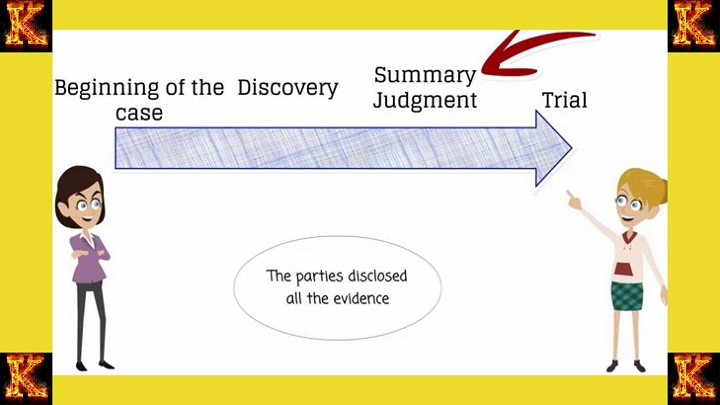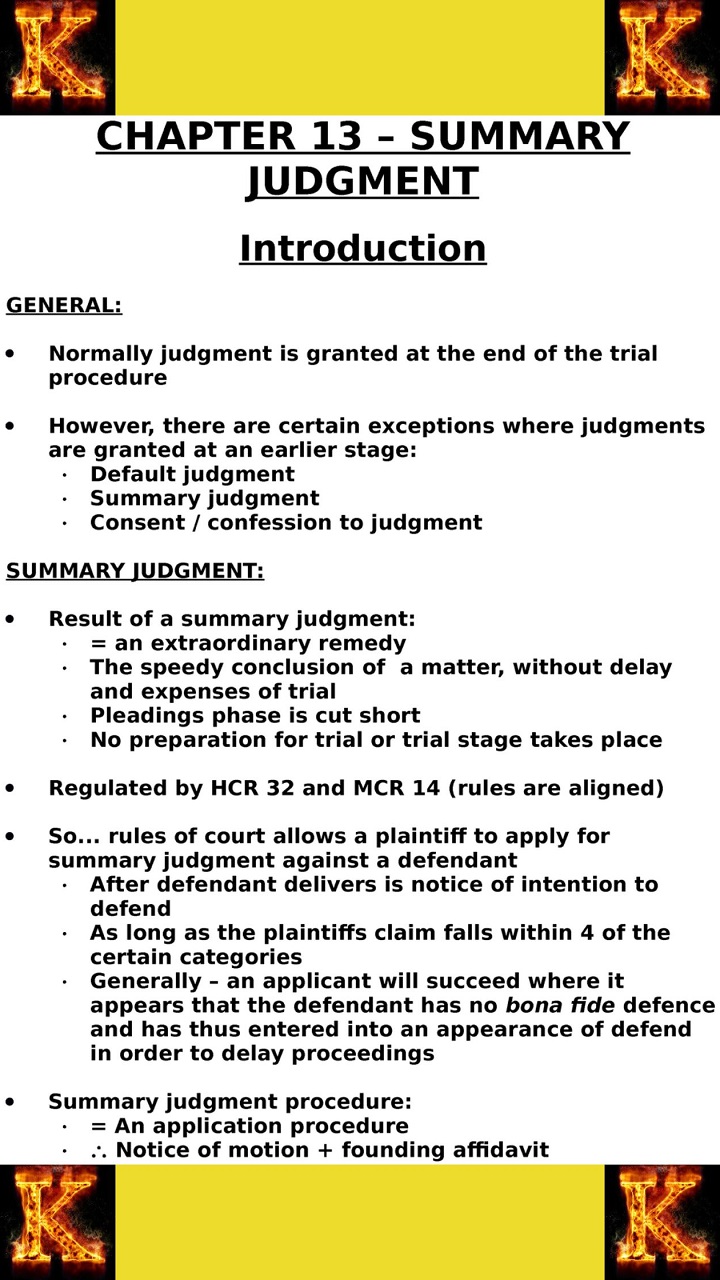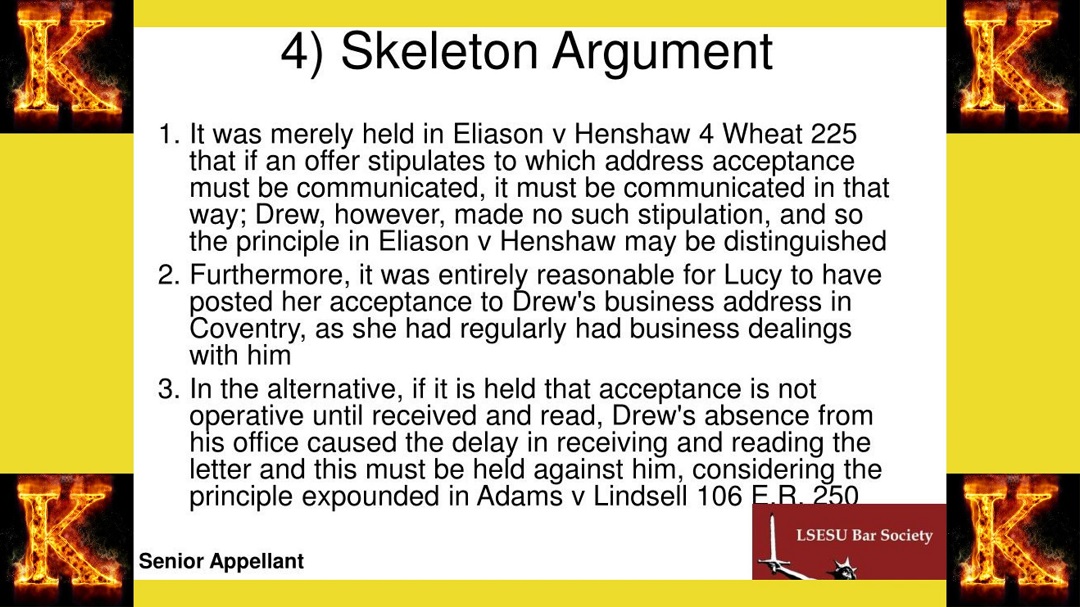Introduction:
In legal proceedings, a skeleton argument is crucial for presenting concise and structured arguments to the court. Specifically, in summary judgment applications, the skeleton argument plays a vital role in advocating for or defending against the granting of summary judgment. This comprehensive guide aims to thoroughly understand the skeleton argument for a case summary judgment, covering its purpose, components, functions, and significance in legal practice.Grounds for Summary Judgment:
The grounds for summary judgment are governed by Civil Procedure Rules (CPR) 24.2, providing the court with the authority to grant summary judgment against the claimant or defendant based on specific criteria. A skeleton argument for a case summary judgment often revolves around these grounds, shaping the legal strategy and presentation of the party's case.
-
Lack of Prospect of Success:
- According to CPR 24.2(a)(i), summary judgment may be granted if the court determines that the claimant has no real prospect of succeeding in the claim or issue.
- This aspect of the skeleton argument focuses on demonstrating why the opposing party's case lacks merit or legal basis, emphasizing weaknesses in their arguments and evidence.
- Example: The skeleton argument may cite relevant case law, statutes, or legal principles to show that the claimant's case is flawed and unlikely to succeed at trial.
-
Lack of Prospect of Successful Defense:
- Similarly, under CPR 24.2(a)(ii), summary judgment may be warranted if the defendant has no real prospect of successfully defending the claim or issue.
- In this context, the skeleton argument highlights deficiencies in the defendant's defense strategy, pointing out legal errors, factual inconsistencies, or procedural defects.
- Example: The skeleton argument may challenge the validity of the defendant's legal defenses, providing counterarguments supported by legal authority and factual evidence.
-
Absence of Compelling Reasons for Trial:
- Additionally, CPR 24.2(b) stipulates that summary judgment may be appropriate if there are no other compelling reasons why the case or issue should proceed to trial.
- The skeleton argument may address this aspect by demonstrating that the issues in dispute can be resolved based on the existing evidence and legal arguments without needing a full trial.
- Example: The skeleton argument may propose that the court's resources can be conserved by disposing of the case through summary judgment, thereby promoting judicial efficiency and expediting dispute resolution.
Read Also: Traditional Criminal Justice System: Order & Justice
Skeleton Argument for a Case Summary Judgment Components:
The skeleton argument for a case summary judgment is a fundamental component of the litigation process, providing a structured framework for presenting legal arguments and supporting evidence to the court. Typically submitted by the plaintiff and defendant, this written document plays a pivotal role in summary judgment proceedings by briefly outlining the parties' positions and the legal basis for their respective claims or defenses. Here, we delve deeper into the key elements and functions of the skeleton argument, emphasizing its significance in facilitating judicial decision-making.Introduction:
The skeleton argument is a crucial document outlining the key legal arguments and evidence supporting the party's position in a case summary judgment. This introductory section provides a concise overview of the nature of the case and the specific relief sought by the party submitting the document. It sets the stage for the skeleton argument's subsequent legal arguments and factual assertions.Statement of Facts:
Following the introduction, the skeleton argument includes a brief statement of the case's relevant facts. This section outlines the chronological sequence of events leading to the legal dispute, emphasizing key factual elements central to the parties' respective positions. This section provides the court with a foundational understanding of the case's background by presenting a clear and concise summary of the facts.Legal Arguments:
The core of the skeleton argument comprises the legal arguments advanced by the party submitting the document. Each legal argument is meticulously crafted to support the party's position and is accompanied by references to applicable case law, statutes, and legal principles. By elucidating the party's interpretation of the law and its application to the facts of the case, this section aims to persuade the court to grant summary judgment in favor of the submitting party.Authorities and Evidence:
In bolstering the legal arguments presented, the skeleton argument cites relevant authorities and evidence, including court decisions, statutes, and expert opinions. These citations substantiate the party's assertions and provide the court with a comprehensive understanding of the dispute's legal framework. By referencing authoritative sources, the party seeks to enhance the credibility and persuasiveness of its arguments before the court.Conclusion:
The skeleton argument culminates with a summary of the key points raised throughout the document. This concluding section reiterates the party's position and the relief sought, emphasizing the desired outcome of the litigation. By restating the salient arguments and underscoring their significance, the conclusion aims to leave a lasting impression on the court and reinforce the party's case for summary judgment. By meticulously crafting each component of the skeleton argument, the submitting party endeavors to present a compelling and persuasive case for summary judgment, thereby securing a favorable outcome in the legal proceedings.
BETWEEN: ELEANOR HARDWICK
[Claimant / Applicant] -and- RELIABLE SCHEDULING LIMITED [Defendant / Respondent]
CLAIMANT'S APPLICATION FOR SUMMARY JUDGMENT: SKELETON ARGUMENT
INTRODUCTION
The claimant, Eleanor Hardwick, seeks summary judgment against the defendant, Reliable Scheduling Limited, under Civil Procedure Rules (CPR) 24.2. This skeleton argument outlines the grounds for the application and elucidates the legal and factual basis supporting the claimant's request for summary judgment.EVIDENCE
In the skeleton argument for this case summary judgment, the claimant will heavily rely on documentary evidence to substantiate the claims and demonstrate the defendant's breach of contract. The evidence presented will include, but not be limited to, contracts, correspondence, and invoices. Here's a breakdown of how this evidence will be utilized:- Contracts: The claimant will submit copies of relevant agreements between the parties. These contracts will outline the terms and conditions agreed upon by both parties and serve as the legal framework for the dispute.
- Correspondence: The skeleton argument will include excerpts of correspondence between the claimant and the defendant. This may include emails, letters, or other written communications that provide insight into the interactions between the parties leading up to the dispute.
- Invoices: Copies of invoices issued by the claimant to the defendant will be submitted as evidence. These invoices will demonstrate the nature of the services rendered or goods supplied by the claimant and the corresponding payment obligations of the defendant.
- Substantiating the Claim: The documentary evidence will be used to support the claimant's assertions regarding the breach of contract by the defendant. This evidence will illustrate how the defendant failed to fulfill their contractual obligations, leading to the dispute.
- Demonstrating Breach of Contract: Through the skeleton argument, the claimant will meticulously analyze the documentary evidence to highlight instances where the defendant deviated from the contract terms. This analysis will reinforce the argument that the defendant's actions constitute a breach of contract.
- Legal Relevance: The documentary evidence presented will be directly relevant to the legal issues raised in the case. The skeleton argument will provide a clear link between the evidence and the legal principles governing breach of contract claims.
- Persuasive Impact: By presenting compelling documentary evidence, the skeleton argument aims to persuade the court of the validity of the claimant's case and the merits of granting summary judgment in their favor.
CASE LAW ELEANOR HARDWICK V. RELIABLE SCHEDULING LIMITED
In the skeleton argument for this case summary judgment, significant emphasis will be placed on precedent cases such as Lowe v. Lombank Ltd and Carlill v. Carbolic Smoke Ball Company. These cases serve as legal authorities that establish principles relevant to the present dispute, reinforcing the claimant's legal position and entitlement to summary judgment.Swain v Hillman
-
Establishment of Legal Criterion:
-
Degree of Conviction:
-
Facts:
- Claimant: Mr. Swain filed a personal injury claim against defendants Mr. Hillman and Mr. Gay.
- Defendants: Mr. Hillman and Mr. Gay are alleged to have sold a property to Mr. Swain, failing to disclose certain defects.
-
Held:
- Legal Standard: The court held that claims seeking trial must demonstrate a "real prospect of success," implying a degree of conviction.
- Application: Swain's claim was deemed to meet this standard, thus denying the defendants' application for summary judgment.
-
Relevance:
- Legal Precedent: The case set a precedent for evaluating claims' viability in summary judgment applications, ensuring meritorious claims proceed to trial.
- Fairness and Justice: Upholding the "real prospect of success" criterion maintains fairness and justice in the legal system by preventing arbitrary dismissals of potentially valid claims.
-
Arguments - Claimant / Applicant:
- Substantive Claim: Mr. Swain's claim demonstrated sufficient merit to proceed to trial, meeting the established legal criterion.
- Prevention of Arbitrary Dismissal: Upholding the "real prospect of success" standard prevents unjust dismissals of claims merely on speculative grounds, ensuring fair access to justice.
-
Arguments - RELIABLE SCHEDULING LIMITED / Defendant / Respondent:
- Possible Defense: RELIABLE SCHEDULING LIMITED could argue for the dismissal of the claim based on lack of substantive evidence or legal basis.
- Application of Legal Standard: The defendant may assert that Mr. Swain's claim fails to meet the requisite "real prospect of success" standard, warranting summary judgment in their favor.

ED&F Man Liquid Products v Patel
-
- Facts: ED&F Man sued Mr. Patel for non-payment of oil purchased, which Mr. Patel argued was void due to a mistake.
- Holding: Applying the Swain v Hillman test, the court found Mr. Patel's defense of mistake could potentially void the contract, warranting the setting aside of the summary judgment.
- These cases define the threshold for a claim's success in summary judgment applications, emphasizing that a claim need not guarantee success but must show some legal and factual basis to proceed to trial.
Lowe v. Lombank Ltd:
This case, [1967] 2 All E.R. 673, heard in the Court of Appeal, is highly relevant to the present matter. In Lowe v. Lombank Ltd, the court addressed issues similar to those in the current dispute, providing guidance on contractual interpretation and remedies for breach of contract. The skeleton argument will analyze the key aspects of Lowe v. Lombank Ltd and demonstrate how its principles support the claimant's case for summary judgment.Carlill v. Carbolic Smoke Ball Company:
Another pivotal case in the skeleton argument is Carlill v. Carbolic Smoke Ball Company, [1893] 1 Q.B. 256 (C.A.). This landmark case established principles related to the formation and enforceability of unilateral contracts, which are directly relevant to the contractual issues in the present dispute. By referencing Carlill v. Carbolic Smoke Ball Company, the claimant aims to strengthen their legal position and bolster the argument for summary judgment.-
-
Relevance to the Present Case:
-
-
-
Legal Position:
-
Easyair Limited v Opal Telecom Limited
- Pertaines to breach of contract, focusing on summary judgment principles.
Three Rivers Dc v Bank of England
- Centered on the interpretation of contractual terms within an agreement.
- Explores how courts consider points of law in summary judgment applications.
Federal Commerce and Navigation v Molena Alpha Inc
- Examines "wrongful termination as repudiatory breach" in a contract.
- Explores the concept of repudiatory breach, allowing termination for fundamental breaches.
Barton & others v Morris & another
- Involves the principle of unjust enrichment.
- Explores situations where one party benefits unjustly at the expense of another.
Henry Boot Constructions Ltd v Alstom Combined Cycle Ltd
- Focuses on a payment dispute within a contract.
- Explores the entitlement to payment for performance under contractual obligations.
L. Schuler AG v Wickman Machine Tools Sales
- Explores the assertion and interpretation of contractual terms.
- Addresses disagreements over the meaning or validity of specific terms within a contract.

LEGISLATION
In the skeleton argument for this case summary judgment, significant reliance will be placed on the Civil Procedure Rules (CPR), particularly CPR 24.2. This statutory provision governs the court's authority to grant summary judgment and forms the legal basis for the claimant's application.-
CPR 24.2:
-
Legal Authority:
-
Application to the Present Case:
-
Legal Interpretation:
FACTUAL BACKGROUND
The claim arises from a contractual dispute wherein the defendant, Reliable Scheduling Limited, failed to fulfill its contractual obligations to the claimant, resulting in damages amounting to £37,500 as evidenced by Exhibit EH/4.THE COURT’S DISCRETION
The court is vested with discretion under CPR 24.2 to grant summary judgment if it deems fit based on the merits of the case and the evidence presented by the parties.LIMB 1: ‘REAL PROSPECT OF SUCCESS AT TRIAL’
The claimant asserts that there exists no real prospect of the defendant successfully defending the claim at trial. The defendant's breach of contract is clear and undisputed, as evidenced by the documentary evidence submitted.LIMB 2: ‘SOME OTHER GOOD REASON’
In addition to the lack of a real prospect of success at trial, there are no other compelling reasons why the case should proceed to trial. The claimant has diligently complied with all pre-action protocols, and no issues of complexity or factual dispute warrant a trial.CONCLUSION
In light of the preceding arguments and evidence presented, the claimant respectfully requests that this honorable court grant summary judgment in her favor, ordering Reliable Scheduling Limited to pay the outstanding sum of £37,500 for services rendered.NAME OF COUNSEL DATE
Read Also: Business Ethics and Social Responsibility for SMEs
Legal Terminology in Summary Judgment:
- Motion for Summary Judgment: A formal request made to the court seeking a decision in favor of the moving party without needing a full trial. This motion is typically supported by a skeleton argument outlining the legal and factual basis for summary judgment.
- Material Facts: Facts central to the legal issues in dispute and could potentially affect the case outcome. Parties highlight material facts to demonstrate their entitlement to summary judgment in a skeleton argument for a case summary judgment.
- Triable Issue: An issue of fact or law that requires resolution by the court at trial. A skeleton argument may assert that there are no triable issues in the case, warranting summary judgment in favor of the moving party.
- Standard of Proof: The level of certainty or persuasion required to establish a particular fact or legal claim. In a summary judgment, the moving party must demonstrate that there are no genuine issues of material fact and that they are entitled to judgment as a matter of law, typically through their skeleton argument.
- Affidavit Evidence: Written statements sworn or affirmed by witnesses and submitted as evidence in support of or opposition to a motion for summary judgment. The skeleton argument often references these affidavits to substantiate the party's assertions.
- Prima Facie Case: A case that, at first glance, appears to have sufficient evidence to support the legal claim or defense. Parties may argue in their skeleton arguments that they have established a prima facie case warranting summary judgment in their favor.
- Burden of Proof: The obligation to present evidence and persuade the court of the truth of a particular proposition. In summary judgment proceedings, the burden may shift between the parties, and the moving party must demonstrate, through their skeleton argument, that they have met their burden to warrant summary judgment.
- Legal Precedent: Previous court decisions that have established legal principles applicable to the case. Parties often cite relevant legal precedents in their skeleton arguments to support their interpretation of the law and persuade the court to grant summary judgment.
- Judicial Discretion: The authority vested in judges to make decisions based on their assessment of the facts and applicable law. While parties may advocate for summary judgment in their skeleton arguments, the ultimate decision rests with the court's discretion.
- Summary Adjudication: A procedure similar to summary judgment but applied to specific issues or claims within a case rather than the entire case. Parties may seek summary adjudication for discrete matters through their skeleton arguments.


Comments are closed!